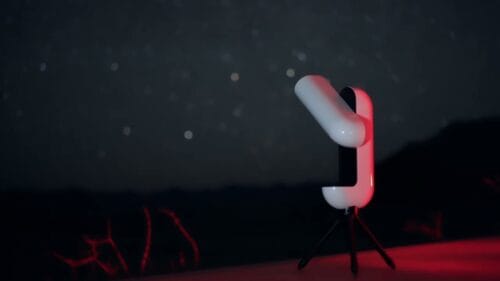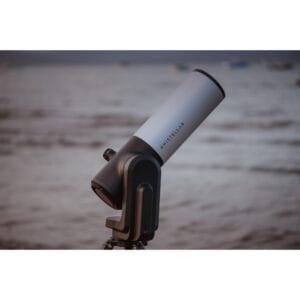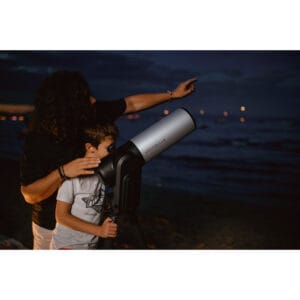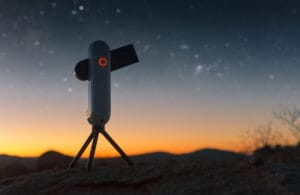Choosing a smart telescope for beginners may seem simple, but the market has quickly become flooded with models offering various features, price points, and performance levels. Whether you’re a child interested in the moon, a parent looking for something educational, or an adult wanting to start astrophotography — not every smart telescope is right for you. In this article, we explain what a smart telescope is, what to look for as a beginner, and which models truly make a difference.
What Exactly is a Smart Telescope?
A smart telescope combines optics with electronics. These telescopes automatically locate celestial objects using GPS, an app, or built-in AI recognition. You don’t need to align manually or deal with complex settings.
Modern smart telescopes like the Seestar S30 and DWARF 3 use stacking technology: they combine dozens or hundreds of images to reduce noise and reveal details. This means that even a relatively small lens can produce impressive results — if you know what you’re doing.
Why are Smart Telescopes Ideal for Beginners?
✓ No alignment needed – They automatically point to the right object.
✓ App control – Everything works via smartphone or tablet.
✓ Instant results – You often see the moon, planets, or nebulae within 1 minute.
✓ Save and share astrophotos – Many models automatically save images.
✓ Compact and portable – No lugging around heavy equipment.
However: this doesn’t mean every smart telescope is right for you.
The Three Best Smart Telescopes for Beginners
1. Seestar S30 – Ideal Entry Model for €500-600

The Seestar S30 is currently the most popular model among beginners worldwide. This compact telescope is fully automated, has a built-in sensor, automatic focusing, and works through an app that does almost everything for you. The results are impressive, especially for the price.
What can you see with it?
✓ Deep-sky objects like the Orion Nebula
✓ Galaxies like Andromeda
Why beginners choose this:
- Ready to use in 2 minutes
- Works even from the city (light pollution is compensated through software)
- Ideal for astrophotography via smartphone
→ View the Seestar S30 in our webshop
2. DWARF 3 – more Control for Technically-Minded Beginners

The DWARF 3 is more compact but offers more manual settings: exposure, gain, stacking. Perfect for those who want to seriously start with astrophotography from the beginning. It has a wider field of view and is perfect for objects like Andromeda or the Pleiades.
Note: This telescope is more powerful but also more sensitive to mistakes. It requires slightly more technical understanding than the Seestar.
3. Seestar S50 – Smarter and more Powerful than the S30

The Seestar S50 is the big brother of the S30: same user-friendliness, but more powerful optics and an improved sensor. The telescope is still fully automated but has a longer focal length and narrower field of view — perfect for smaller deep-sky objects like the Ring Nebula or planetary nebulae.
What makes the S50 special?
- Higher resolution thanks to more advanced sensor
- Suitable for detailed images of smaller objects
- More zoom, but therefore slightly less suitable for wide sky areas
Why beginners choose this:
- Comes with tripod and carrying case
- Same easy operation as the S30
- More detail in planetary and deep-sky images
| Model | Ease of use | Field of view | Strength | Sensor | For whom? | Price (indicative) |
|---|---|---|---|---|---|---|
| Seestar S30 | ★★★★★ | Wider (0.7° x 1.3°) | Average | IMX462 | Complete beginners | €549 |
| Seestar S50 | ★★★★★ | Narrower (more zoom) | Strong | IMX462 (improved) | Beginners who want more detail | €719 |
| DWARF 3 | ★★★★☆ | Very wide (2.9° x 1.6°) | Advanced | IMX678 (8.3 MP) | Technically-minded starters | €589 |
What should You Look for when Buying?
- Want to start astrophotography immediately? → Choose a model with automatic stacking like the Seestar S30/S50.
- Want to learn more about settings? → Then the DWARF 3 is a good step.
- Is ease of use most important? → Choose a fully automated telescope with fixed app integration.
- Buying this for a child or classroom? → Look for stability, user-friendliness, and educational content.
Conclusion: this is the Best Smart Telescope for Beginners
For 95% of beginners, the Seestar S30 is the best choice. It combines simplicity, powerful optical performance, and an excellent price tag. Those wanting more control can switch to the DWARF 3 — but for quick results and a great first experience, the Seestar is unbeatable.
📦 Order Directly or Learn more?
Have questions or want personal advice? Contact us via chat, email, or phone – our specialists are happy to help.





